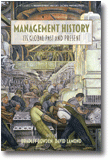
Management History
Its Global Past & Present
Edited by:
Bradley Bowden, Griffith University
David Lamond, Victoria University
A volume in the series: Management History: Global Perspectives. Editor(s): Matteo Cristofaro, University of Rome Tor Vergata. Jeffrey Muldoon, Emporia State University. James Fowler, University of Essex. Andrea Colli, Bocconi University.
Published 2015
This book has two broad purposes. First, it seeks to determine whether or not there is a “universal” management model through an examination of circumstance in a number of different nations and industries. Second, it brings to a wider audience some of the leading research in the field of management history. In doing so, it highlights the importance of the Management History Division of the Academy of Management in fostering and disseminating new understandings of management and its development. The book indicates that, while there has been much variance in managerial practices across time and space, we can nevertheless speak of a “universal” managerial model.
Emerging in association with Britain’s Industrial Revolution, the spread of competitive pressures progressively demanded that enterprises respond in broadly common ways if they were to survive. These broad commonalities can be seen in the diverse industries that this book considers – the beef industry of the Northern Plains of the United States in the nineteenth century, the trading activities of the Dutch East India Company, the United States and Australian railroads, and the manufacturing methods of the Ford Motor Company during the early twentieth century. In each of these circumstances, industries and firms had to constantly adapt to changes in both capital and consumer markets. This is evident even in the case of the Ford Motor Company which, as James Wilson’s chapter indicates, was in its early days “flexible” rather than Fordist, constantly adjusting production and inventories in accordance with consumer demand. Such responses to global markets is also found in the realms of ideas and education, where the book’s study of trends in business education highlights the growing dominance of commercial factors and of intellectual concepts stemming from the United States.
The power of management commonalities is also found in the book’s study of Australia and the United States. In Australia, governments long sought to isolate the national economy from global trends so as to boost manufacturing and local employment. Ultimately, however, this proved unsuccessful as Australian production became increasingly uncompetitive. A severe process of economic readjustment, with often adverse social effects, is also found in the book’s chapter on the United States, which highlights the major changes that have occurred since the 1960s. This book also considers how managerial organizations have been forced to adapt and the intellectual debates that have accompanied this. Finally, in Regina Greenwood’s chapter, we have an account of the Management History Division of the Academy of Management, an organization which has provided the fulcrum for the generation and dissemination of management history for the last 3 decades.
CONTENTS
Introduction, Bradley Bowden and David Lamond. The Dutch East India Company: An Early Modern Optical Illusion, Wim van Lent. Blazing a Trail from Markets to Politics: Wyoming’s 19th Century Cattle Kings, Roland E. Kidwell. Behemoths: A Comparative Analysis of United States and Australian Railroad Management, 1870–1901, Bradley Bowden and Peta Stevenson‐Clarke. Ford’s Development and Use of the Assembly Line, 1908–1927, James M. Wilson. Peculiar Legacies: Geography, State Intervention, and the Shaping of Australian Business, Bradley Bowden. A Culture of Free Enterprise: Employer Management Policies in the United States Since 1970, Jonathan Rees. What Happens to the Professor? Business Schools, Corporatization, and Eroding Professionalism, Kerttu Kettunen, Katariina Juusola, and Kimmo Alajoutsijärvi. Management and Organizational History: Extending the State‐of‐the‐Art to Historicist Interpretivism, Milorad M. Novicevic, Jason Owen, Jennifer Palar, Ifeoluwa Tobi Popooola, and David Marshall. A First Look at the First 30 Years of the First Division: The Management History Division, Regina Greenwood.
-
Paperback9781681231853
Web price: $45.04 (Reg. 52.99)
-
Hardcover9781681231860
Web price: $80.74 (Reg. 94.99)
- eBook9781681231877

- BUS041000 - BUSINESS & ECONOMICS: Management
- BUS055000 - BUSINESS & ECONOMICS: Reference
- BUS000000 - BUSINESS & ECONOMICS: General
-
 Dark and Destructive Leadership
Dark and Destructive Leadership
-
 Digital Transformation
Organizational Challenges and Management Transformation Methods
Digital Transformation
Organizational Challenges and Management Transformation Methods
-
 Diversity, Equity, and Inclusion Insights in Practice
Diversity, Equity, and Inclusion Insights in Practice
-
 Management Consulting in the Era of the Digital Organization
Management Consulting in the Era of the Digital Organization
-
 Perspectives on Race in Organizations
Perspectives on Race in Organizations
-
 The Entrepreneurship SIG at the European Academy of Management
Setting the Base for Tomorrow's Challenges
The Entrepreneurship SIG at the European Academy of Management
Setting the Base for Tomorrow's Challenges
-
 The Plight of Stigmatized Groups in Organizations
The Plight of Stigmatized Groups in Organizations

